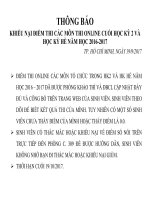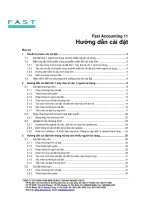Introduction tem 2017 09
Bạn đang xem bản rút gọn của tài liệu. Xem và tải ngay bản đầy đủ của tài liệu tại đây (12.82 MB, 199 trang )
Introduction: Basics of Transmission Electron Microscopy
Vietnam National University-HCMC
Ho Chi Minh City University of Technology
Faculty of Materials Technology
Introduction:
Basics of Transmission Electron
Microscopy (TEM)
HCMUT
Faculty of Materials Technology, Ho Chi Minh City University of Technology
268 Ly Thuong Kiet street, Ward 14, District 10, Ho Chi Minh City, Viet Nam
Tell: 38661320; Fax: 38661843 Copyright(c) 2000. All rights reserved.
Introduction: Basics of Transmission Electron Microscopy
Vietnam National University-HCMC
Ho Chi Minh City University of Technology
Faculty of Materials Technology
Outline_________________________
1. History
2. What is microcopy
3. Why we use electrons as a probe
4. Electron-matter interactions in a thin sample
5. Components of the TEM
6. TEM imaging modes
HCMUT
Faculty of Materials Technology, Ho Chi Minh City University of Technology
268 Ly Thuong Kiet street, Ward 14, District 10, Ho Chi Minh City, Viet Nam
Tell: 38661320; Fax: 38661843 Copyright(c) 2000. All rights reserved.
Introduction: Basics of Transmission Electron Microscopy
HCMUT
Faculty of Materials Technology, Ho Chi Minh City University of Technology
268 Ly Thuong Kiet street, Ward 14, District 10, Ho Chi Minh City, Viet Nam
Tell: 38661320; Fax: 38661843 Copyright(c) 2000. All rights reserved.
Vietnam National University-HCMC
Ho Chi Minh City University of Technology
Faculty of Materials Technology
Introduction: Basics of Transmission Electron Microscopy
HCMUT
Faculty of Materials Technology, Ho Chi Minh City University of Technology
268 Ly Thuong Kiet street, Ward 14, District 10, Ho Chi Minh City, Viet Nam
Tell: 38661320; Fax: 38661843 Copyright(c) 2000. All rights reserved.
Vietnam National University-HCMC
Ho Chi Minh City University of Technology
Faculty of Materials Technology
Introduction: Basics of Transmission Electron Microscopy
An extremely brief history
HCMUT
Faculty of Materials Technology, Ho Chi Minh City University of Technology
268 Ly Thuong Kiet street, Ward 14, District 10, Ho Chi Minh City, Viet Nam
Tell: 38661320; Fax: 38661843 Copyright(c) 2000. All rights reserved.
Vietnam National University-HCMC
Ho Chi Minh City University of Technology
Faculty of Materials Technology
Introduction: Basics of Transmission Electron Microscopy
Vietnam National University-HCMC
Ho Chi Minh City University of Technology
Faculty of Materials Technology
(A) JEM 1.25 MeV HVEM. Note the size of the instrument; often the high-voltage tank is in another
room above the column. (B) Zeiss HRTEM with a Cs corrector and an in-column energy filter.
HCMUT
Faculty of Materials Technology, Ho Chi Minh City University of Technology
268 Ly Thuong Kiet street, Ward 14, District 10, Ho Chi Minh City, Viet Nam
Tell: 38661320; Fax: 38661843 Copyright(c) 2000. All rights reserved.
Introduction: Basics of Transmission Electron Microscopy
Vietnam National University-HCMC
Ho Chi Minh City University of Technology
Faculty of Materials Technology
(C) Hitachi 200 keV dedicated STEM; note the absence of a viewing chamber. Such instruments are often
designed to aid failure analysis for the semiconductor device manufacturers. Specimens thinned from wafers
on the production line can be easily transferred and examined. (D) JEOL 200 keV TEM/STEM; note also the
absence of a viewing chamber.
HCMUT
Faculty of Materials Technology, Ho Chi Minh City University of Technology
268 Ly Thuong Kiet street, Ward 14, District 10, Ho Chi Minh City, Viet Nam
Tell: 38661320; Fax: 38661843 Copyright(c) 2000. All rights reserved.
Introduction: Basics of Transmission Electron Microscopy
Vietnam National University-HCMC
Ho Chi Minh City University of Technology
Faculty of Materials Technology
E) Nion 200 keV ultrahigh vacuumSuperSTEM; the only US-manufactured (S)TEM and current holder of the world record
image resolution (F) FEI Titan. Comparison with Ruska’s instrument (Figure 1.1), which is 70–80 years older than these
instruments, is instructive.
HCMUT
Faculty of Materials Technology, Ho Chi Minh City University of Technology
268 Ly Thuong Kiet street, Ward 14, District 10, Ho Chi Minh City, Viet Nam
Tell: 38661320; Fax: 38661843 Copyright(c) 2000. All rights reserved.
Introduction: Basics of Transmission Electron Microscopy
Vietnam National University-HCMC
Ho Chi Minh City University of Technology
Faculty of Materials Technology
What is Microscopy ?___________________________
Wikipedia defines it: Microscopy is the technical field of using
microscopes to view objects and areas of objects that cannot be
seen with the naked eye (objects that are not within the
resolution range of the normal eye).
HCMUT
Faculty of Materials Technology, Ho Chi Minh City University of Technology
268 Ly Thuong Kiet street, Ward 14, District 10, Ho Chi Minh City, Viet Nam
Tell: 38661320; Fax: 38661843 Copyright(c) 2000. All rights reserved.
Introduction: Basics of Transmission Electron Microscopy
Vietnam National University-HCMC
Ho Chi Minh City University of Technology
Faculty of Materials Technology
THERE ARE FOUR BASIC TYPES OF MICROSCOPIES:
1. Optical microscopes: Bright field microscope, Dark
field microscope, Phase
contrast microscope,
Fluorescent microscope…
2. Electron microscopes: SEM, TEM…
3. Scanning probe microscopes: AFM, NSOM, STM...
4. Ion microscopes: FIB…
HCMUT
Faculty of Materials Technology, Ho Chi Minh City University of Technology
268 Ly Thuong Kiet street, Ward 14, District 10, Ho Chi Minh City, Viet Nam
Tell: 38661320; Fax: 38661843 Copyright(c) 2000. All rights reserved.
Introduction: Basics of Transmission Electron Microscopy
HCMUT
Faculty of Materials Technology, Ho Chi Minh City University of Technology
268 Ly Thuong Kiet street, Ward 14, District 10, Ho Chi Minh City, Viet Nam
Tell: 38661320; Fax: 38661843 Copyright(c) 2000. All rights reserved.
Vietnam National University-HCMC
Ho Chi Minh City University of Technology
Faculty of Materials Technology
Introduction: Basics of Transmission Electron Microscopy
What is Microscopy
HCMUT
Faculty of Materials Technology, Ho Chi Minh City University of Technology
268 Ly Thuong Kiet street, Ward 14, District 10, Ho Chi Minh City, Viet Nam
Tell: 38661320; Fax: 38661843 Copyright(c) 2000. All rights reserved.
Vietnam National University-HCMC
Ho Chi Minh City University of Technology
Faculty of Materials Technology
Introduction: Basics of Transmission Electron Microscopy
Vietnam National University-HCMC
Ho Chi Minh City University of Technology
Faculty of Materials Technology
Why Electron Microscope?
• Light Microscopes are limited by the physics of light to 500x or
1000x magnification and a resolution of 0.2 micrometers.
• In the early 1930's there was a scientific desire to see the fine
details of the interior structures of organic cells (nucleus,
mitochondria...etc.).
• This required 10,000x plus magnification which was just not
possible using Light Microscopes.
HCMUT
Faculty of Materials Technology, Ho Chi Minh City University of Technology
268 Ly Thuong Kiet street, Ward 14, District 10, Ho Chi Minh City, Viet Nam
Tell: 38661320; Fax: 38661843 Copyright(c) 2000. All rights reserved.
Introduction: Basics of Transmission Electron Microscopy
What is electron microscopy
The electron microscopy is the
use of specialized microscopes
that interact a high energy
electron beam with samples as a
means to probe a material’s
structure
Electron microscopes have a
greater resolving power than
light microscopes, allowing it to
see much smaller objects in finer
detail (sub nanometer resolution)
EMs are large, expensive pieces
of equipment, generally in a
small, specially designed room
and requiring trained personnel
to operate them.
HCMUT
Faculty of Materials Technology, Ho Chi Minh City University of Technology
268 Ly Thuong Kiet street, Ward 14, District 10, Ho Chi Minh City, Viet Nam
Tell: 38661320; Fax: 38661843 Copyright(c) 2000. All rights reserved.
Vietnam National University-HCMC
Ho Chi Minh City University of Technology
Faculty of Materials Technology
Introduction: Basics of Transmission Electron Microscopy
Vietnam National University-HCMC
Ho Chi Minh City University of Technology
Faculty of Materials Technology
Why we use Electrons as a probe:
1. Easy to produce high brightness electron beams
2. Easily manipulated
3. High energy electrons have a short wavelength
4. Interact strongly with matter
HCMUT
Faculty of Materials Technology, Ho Chi Minh City University of Technology
268 Ly Thuong Kiet street, Ward 14, District 10, Ho Chi Minh City, Viet Nam
Tell: 38661320; Fax: 38661843 Copyright(c) 2000. All rights reserved.
Introduction: Basics of Transmission Electron Microscopy
Why we use electrons as a probe:
Electrons are accelerated to high
energies (which gives high spatial
resolution!)
Electron beams are
monochromatic (having the same
energy means less chromatic
aberrations!)
Electrons beams are shaped (e.g.,
focused, collimated etc.) and
directed onto the samples using
electron static and magnetic lens
and deflector coils
The interaction of the high
energy electrons produces
secondary signals that have
intrinsic information, specific to
the sample’s properties.
HCMUT
Faculty of Materials Technology, Ho Chi Minh City University of Technology
268 Ly Thuong Kiet street, Ward 14, District 10, Ho Chi Minh City, Viet Nam
Tell: 38661320; Fax: 38661843 Copyright(c) 2000. All rights reserved.
Vietnam National University-HCMC
Ho Chi Minh City University of Technology
Faculty of Materials Technology
Introduction: Basics of Transmission Electron Microscopy
Vietnam National University-HCMC
Ho Chi Minh City University of Technology
Faculty of Materials Technology
Why we use electrons as a probe: Resolution
HCMUT
Faculty of Materials Technology, Ho Chi Minh City University of Technology
268 Ly Thuong Kiet street, Ward 14, District 10, Ho Chi Minh City, Viet Nam
Tell: 38661320; Fax: 38661843 Copyright(c) 2000. All rights reserved.
Introduction: Basics of Transmission Electron Microscopy
Vietnam National University-HCMC
Ho Chi Minh City University of Technology
Faculty of Materials Technology
Why we use electrons as a probe: Resolution
HCMUT
Faculty of Materials Technology, Ho Chi Minh City University of Technology
268 Ly Thuong Kiet street, Ward 14, District 10, Ho Chi Minh City, Viet Nam
Tell: 38661320; Fax: 38661843 Copyright(c) 2000. All rights reserved.
Introduction: Basics of Transmission Electron Microscopy
Vietnam National University-HCMC
Ho Chi Minh City University of Technology
Faculty of Materials Technology
Why we use electrons as a probe: Resolution?
TEM at 60,000 volts has a resolving power
of about 0.0025 nm. Maximum useful magnification
of about 100 million times!!!
HCMUT
Faculty of Materials Technology, Ho Chi Minh City University of Technology
268 Ly Thuong Kiet street, Ward 14, District 10, Ho Chi Minh City, Viet Nam
Tell: 38661320; Fax: 38661843 Copyright(c) 2000. All rights reserved.
Introduction: Basics of Transmission Electron Microscopy
Vietnam National University-HCMC
Ho Chi Minh City University of Technology
Faculty of Materials Technology
What are electron microscopes?
1.
2.
3.
4.
Electron Microscopes are scientific instruments that use a
beam of highly energetic electrons to examine objects on a
very fine scale which yield the following information:
Topography:
The surface features of an object (hardness, reflectivity...etc.)
Morphology:
The shape and size of the particles(ductility, strength,
reactivity...etc.)
Composition:
The elements and compounds that the object is composed of
and the relative amounts of them.
Crystallographic Information:
How the atoms are arranged in the object.
HCMUT
Faculty of Materials Technology, Ho Chi Minh City University of Technology
268 Ly Thuong Kiet street, Ward 14, District 10, Ho Chi Minh City, Viet Nam
Tell: 38661320; Fax: 38661843 Copyright(c) 2000. All rights reserved.









